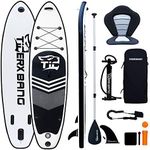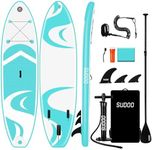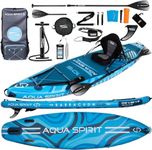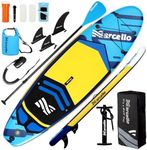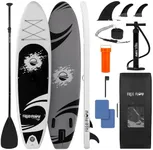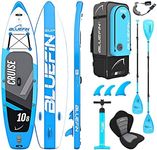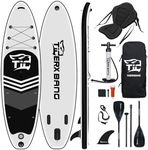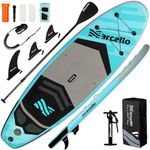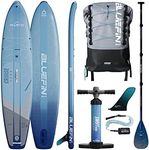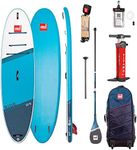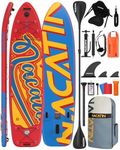Buying Guide for the Best Inflatable Paddle Boards
Choosing the right inflatable paddle board can greatly enhance your paddling experience. Whether you're a beginner or an experienced paddler, selecting a board that suits your needs and preferences is crucial. Consider where you'll be using the board, your skill level, and what activities you plan to do, such as yoga, racing, or casual paddling. Here are some key specifications to help you make an informed decision.Board LengthBoard length affects the board's speed, stability, and maneuverability. Shorter boards (under 10 feet) are more maneuverable and better for surfing or children. Medium boards (10-12 feet) are versatile and suitable for all-around use, including yoga and casual paddling. Longer boards (over 12 feet) are faster and track better, making them ideal for racing or long-distance paddling. Choose a length based on your intended use and skill level.
Board WidthBoard width impacts stability and speed. Wider boards (over 32 inches) offer more stability, making them great for beginners, yoga, or carrying extra gear. Medium-width boards (30-32 inches) provide a balance of stability and speed, suitable for intermediate paddlers. Narrow boards (under 30 inches) are faster but less stable, ideal for advanced paddlers or racing. Consider your balance and the type of paddling you'll be doing when selecting the width.
Board ThicknessBoard thickness affects buoyancy and rigidity. Thicker boards (6 inches) provide more buoyancy and are stiffer, supporting heavier riders and offering better performance in rough water. Thinner boards (4-5 inches) are lighter and easier to carry but may not support as much weight. Choose a thickness based on your weight and the conditions you'll be paddling in.
Board VolumeBoard volume, measured in liters, indicates the board's buoyancy. Higher volume boards can support more weight and are more stable, making them suitable for beginners or carrying extra gear. Lower volume boards are less buoyant and more agile, preferred by experienced paddlers. Match the board volume to your weight and the type of paddling you plan to do.
Construction MaterialThe construction material affects the board's durability, weight, and performance. Most inflatable paddle boards are made from PVC with drop-stitch construction, which provides a good balance of durability and rigidity. Some boards may have additional layers or reinforcements for extra durability. Consider the material based on how often you'll use the board and the conditions you'll be paddling in.
Fin SetupFin setup influences the board's tracking and maneuverability. Single fin setups are simple and provide good tracking, suitable for flat water paddling. Three-fin (2+1) setups offer a balance of tracking and maneuverability, ideal for all-around use. Removable fins allow customization based on conditions. Choose a fin setup that matches your paddling style and the environments you'll be in.
Weight CapacityWeight capacity indicates the maximum weight the board can support while maintaining performance. It's important to consider your weight, plus any additional gear or passengers. Exceeding the weight capacity can affect stability and performance. Choose a board with a weight capacity that comfortably supports your needs.
AccessoriesAccessories can enhance your paddling experience. Common accessories include paddles, pumps, carry bags, leashes, and repair kits. Some boards come as complete packages with all necessary accessories, while others may require separate purchases. Consider what accessories are included and what you might need based on your paddling activities.
